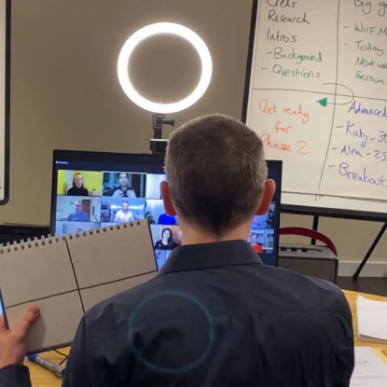“A hybrid meeting is not simply an in-person meeting with some people joining remotely online.“
Hybrid Meeting Mistakes – How Many Are You Making?
The coronavirus pandemic brought remote working into the spotlight.
In 2020, the number of people working from home in the UK more than doubled, as remote working offered safe, flexible working opportunities to businesses in an uncertain world.
Now that we’re coming out of the pandemic, it seems that these changes to working practices will be permanent. A recent survey suggested that a whopping 90% of organisations are planning to adopt a hybrid approach for the post-pandemic world, blending office and home-based working.
Remote working challenges for businesses
One big challenge for businesses that adopt the hybrid model is creating an equitable experience for employees working on-site and remotely. This is particularly tricky when it comes to hosting meetings.
Hybrid meetings require much more careful thought and planning than traditional ones – and failing to do so can leave some members of your team feeling isolated. One recent survey showed that 71% of workers struggle with the friction and technical challenges that come with hybrid meetings, even though most workers prefer the hybrid approach.
The good news is that with some straightforward adjustments, you can make your hybrid meetings a much better experience for both remote and office-based workers: and a happy team is a productive team!
Here are some of the most common hybrid meeting mistakes businesses make – and what you can do about them.
Your meeting is not an actual hybrid meeting
One of the biggest things businesses get wrong is their understanding of what ‘hybrid’ really means.
Many people assume that having a handful of employees remoting into an office-based meeting makes it a hybrid one: it doesn’t.
A hybrid meeting is not simply an in-person meeting with people joining remotely online. Neither is it having a room full of people all staring down at their laptops on a video conference call.
A genuine hybrid meeting offers attendees an equal opportunity and experience; however they are joining the meeting. It should be well thought through and make maximum use of technology to foster an environment of genuine collaboration.
To offer your teams the opportunity for hybrid working means putting measures in place to enable teams to truly work together and remove barriers.
You’re not thinking ‘digital first’
When planning a hybrid meeting, it’s essential to adopt a ‘digital first’ approach. This means considering the needs of the remote participants first and foremost to ensure that their experience will match those joining in person.
Participants joining remotely face challenges that those in person may not, such as ‘Zoom fatigue’ and feelings of isolation or disenfranchisement, so think about how to plan your meeting to minimise these challenges.
Here are things to consider when developing your ‘digital first’ hybrid meeting strategy:
- How long will your meeting last, and will your remote participants need a screen break?
- Will you require your remote participants to have cameras on or off? If they keep their cameras on, what will you do to help minimise “Zoom fatigue”? You may wish to consider factoring in periods where cameras can be switched off.
- Sharing material: how will you ensure that your remote participants see slides in detail? If you’re planning to write on a flip chart, think about the experience your remote participants will have: an online whiteboard such as Miro or Stormboard will help to ensure that all participants can clearly see shared content.
- When asking for questions or comments, ask your virtual attendees for their contribution before those in the room. This will ensure that they feel valued.
Considering the meeting experience from all perspectives will vastly improve your hybrid meeting experience. Think about what the remote participants need to see, hear, and experience to engage with your meeting fully.
Your tech is not good enough
Successful hybrid meetings require a sophisticated level of technology that will allow for clear, crisp audio and video, both for those in the room and those joining remotely.
Simply put, the better the technology at your disposal, the better experience your teams will have during a hybrid meeting.
For all participants to be seen and heard, you will need:
In the room
- A high-quality camera setup that allows remote participants to see the body language and facial expressions of the people attending in person. Two cameras can give you a wide shot of the room and another which focuses on the person speaking. Zoom or Teams-enabled rooms are designed for this purpose and are very effective.
- Alternatively, a portable conference room camera (like this one from Owl Labs) will allow 360 degree, high definition views of the room with automatic zoom that can focus on the person speaking.
Remotely
- Remote participants can use their built-in webcams but should consider using an external lavalier microphone to ensure their sound is clear and audible.
- Ensure that your remote delegates understand how to make the most of their technical setup and get their lighting, sound, and camera position right so their body language and facial expressions can also be seen clearly.
Technology is the thing that is most likely to go wrong in any hybrid meeting, so investing in the right kit is essential.
Whatever kit you have, it’s worth spending 10 to 15 minutes before the meeting to check that everything is working. Arrange to connect with one of the virtual attendees or moderators before you start to do a technical check. This helps reassure you that the meeting will run smoothly once it begins.
You haven’t assigned a moderator
Trying to keep track of participants in the room and joining online can be tricky, especially if you have large numbers of people attending the meeting.
Assigning a moderator to help you manage the online section of the meeting is a helpful way to keep the discussion focused and on track. A moderator can monitor the chatbox, watch out for any ‘raised hands’ from the virtual team, and help deal with any technical issues without disrupting the meeting for everyone else.
Without a moderator, you may end up with individuals talking over one another or missing people’s contributions altogether.
You’re not planning the meetings well enough
Hybrid meetings require more careful planning than traditional meetings.
One essential factor for a successful hybrid meeting is sending out an agenda in advance so that all delegates understand what the meeting is for and how it will flow.
Sending out reading material in advance can also help your teams make the best use of their meeting time. If you have documents, reports, spreadsheets or slides, send them out to delegates before the meeting with the requirement that they read it and come equipped with any questions or comments.
It will not only save you time in the meeting, but it will also give your meeting much more focus and purpose.
Your meetings are too long
Long, drawn-out meetings do not work as well as shorter, more focused ones in a hybrid environment.
When planning your hybrid meeting, think about what you can do to cut down the length and aim for a more concise, focused session. This will be better for productivity and will help to keep people engaged.
If your traditional face-to-face meeting would typically last an hour, try to make your hybrid version no longer than around 40 minutes. This will help keep teams energised and motivated and avoid virtual attendees suffering from screen fatigue.
You can also try hosting “speedy meetings”, which finish 10-15 minutes or more before the scheduled end time, giving your attendees time to stretch their legs, catch up on other work or take a screen break before their next session.
You’re afraid of change
Hybrid meetings are a relatively new way of working, which require time, investment and a bit of a leap of faith to do them well.
If you’re afraid of changing your business’s meeting style or habits, then you won’t be able to fully embrace the opportunities that hybrid meetings can offer your team.
Change your mindset and explore the different options that you can put in place to run successful hybrid meetings. By genuinely considering what you will need to create an equitable experience for all of your team members, you can ensure that you can host effective, collaborative and creative meetings whilst reaping the benefits of flexible working.
If you’d like to learn more about how Body Talk can support your business in developing engaging and impactful hybrid meeting practices, get in touch with us today.




















